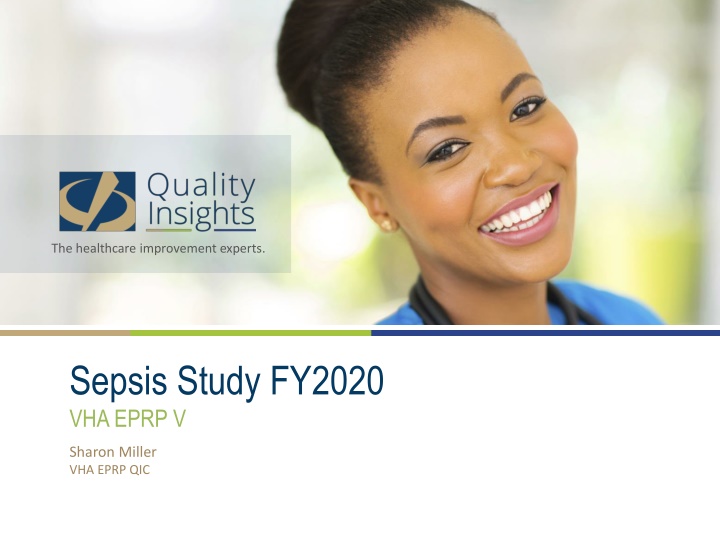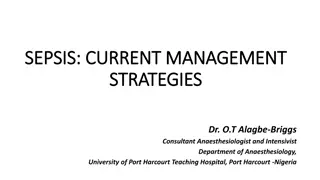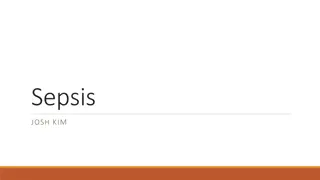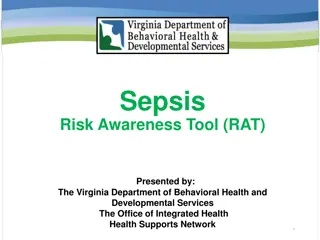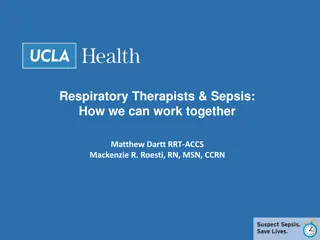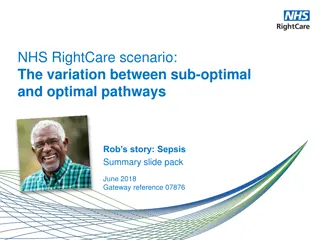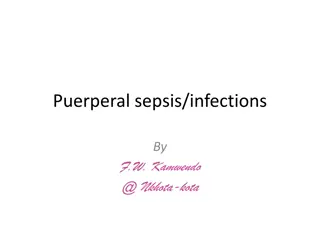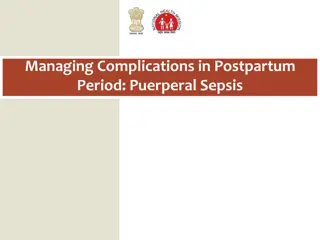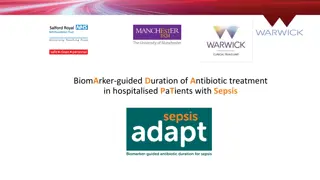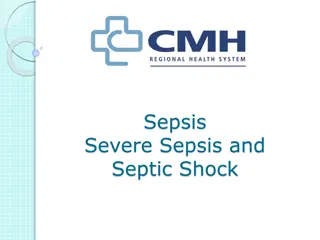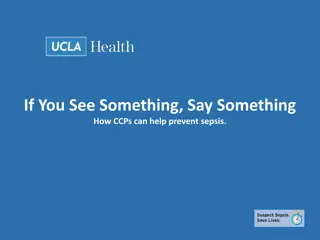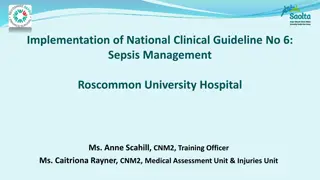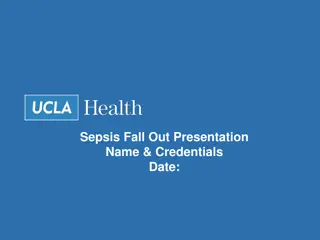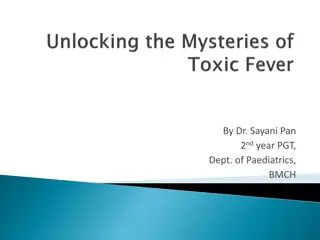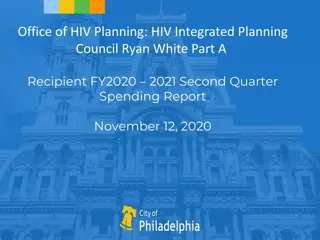Sepsis Study FY2020
The Sepsis Study FY2020 conducted by VHA EPRP under the leadership of Sharon Miller focuses on the SEP-1 measure, early management bundle for severe sepsis, and septic shock. It delves into interventions including lactate measurement, blood cultures, antibiotic administration, fluid resuscitation, and more to effectively treat severe sepsis in adult patients.
Download Presentation

Please find below an Image/Link to download the presentation.
The content on the website is provided AS IS for your information and personal use only. It may not be sold, licensed, or shared on other websites without obtaining consent from the author.If you encounter any issues during the download, it is possible that the publisher has removed the file from their server.
You are allowed to download the files provided on this website for personal or commercial use, subject to the condition that they are used lawfully. All files are the property of their respective owners.
The content on the website is provided AS IS for your information and personal use only. It may not be sold, licensed, or shared on other websites without obtaining consent from the author.
E N D
Presentation Transcript
The healthcare improvement experts. Sepsis Study FY2020 VHA EPRP V Sharon Miller VHA EPRP QIC
Study Purpose VHA Office of Reporting, Analytics, Performance, Improvement and Deployment (RAPID) will begin collecting and reporting the SEP-1 measure for CMS. This will be a Pilot Study. DACs and Exits will be required for facility information NO formal Exit conference required
SEP-1 Measure: Early Management Bundle, Severe Sepsis/Septic Shock Composite measure that includes a bundle of interventions intended to effectively treat severe sepsis and septic shock Focuses on adults 18 years and older with a diagnosis of severe sepsis or septic shock Assesses: o measurement of lactate o obtaining blood cultures o administering broad spectrum antibiotics o fluid resuscitation o vasopressor administration o reassessment of volume status and tissue perfusion o repeat lactate measurement First three interventions should occur within 3 hours of presentation of severe sepsis; fourth within 3 hours of septic shock; next two within 6 hours of presentation of septic shock; last intervention within 6 hours of severe sepsis.
SEP-1 Numerator: patients who received ALL of the following: Within three hours of presentation of severe sepsis: Initial lactate level Broad spectrum or other antibiotics administered Blood cultures drawn prior to antibiotics AND received within six hours of presentation of severe sepsis, ONLY if the initial lactate is elevated Repeat lactate level measurement
SEP-1(cont.) AND within three hours of initial hypotension OR septic shock Resuscitation with 30 mL/kg crystalloid fluids AND within six hours of septic shock presentation, ONLY if hypotension persists after fluid administration: Vasopressors are administered AND within six hours of septic shock presentation, if hypotension persists after fluid administration or initial lactate >= 4 mmol/L Repeat volume status and tissue perfusion assessment is performed
SEP-1 (cont.) Denominator: Inpatients age 18 and over with an ICD- 10-CM Principal or Other Diagnosis Code of Sepsis, Severe Sepsis or Septic Shock as defined in Appendix A, Table 4.01 Excluded Populations: o Comfort Care or Palliative Care within 6 hours of severe sepsis OR septic shock presentation o Contraindication to care within 6 hours of severe sepsis OR septic shock presentation o LOS > 120 days o Transfer in from another acute care facility o Enrolled in clinical trial for sepsis, severe sepsis, septic shock o Patients with severe sepsis OR septic shock discharged within 6 hours of presentation o Patients receiving antibiotics for >24 hours prior to presentation
SEP-1 Sub-Measures RAPID currently electing to report 5 sub- measures Sep1a Denominator All acute care inpatients with a diagnosis of Severe Sepsis Numerator Patients who received ALL the following within three hours of presentation of severe sepsis: Initial lactate level measurement Broad spectrum or other antibiotics administered Blood cultures drawn prior to antibiotics
Sub-Measures Sep1b Denominator All acute care inpatients with a diagnosis of Severe Sepsis AND initial lactate is elevated. Numerator Patients who received a repeat lactate level within six hours of presentation of severe sepsis
Sub-Measures Sep1c Denominator All acute care inpatients with a diagnosis of Severe Sepsis AND have hypotension OR have a diagnosis of Septic Shock Numerator Patients who received resuscitation with 30 mL/kg crystalloid fluids within three hours of initial hypotension OR septic shock
Sub-Measures Sep1d Denominator All acute care inpatients with septic shock AND hypotension that persists after fluid administration. Numerator Patients who receive vasopressors within six hours of septic shock presentation
Sub-Measures Sep1e Denominator All acute care inpatients with septic shock AND hypotension that persists after fluid administration OR initial lactate >= 4mmol/L Numerator Patients who have a repeat volume status AND tissue perfusion assessment performed within six hours of septic shock presentation
Data Collection Questions Instrument has 54 questions Most of first 11 should be familiar Q1 arrvdate Enter earliest date arrived in acute care Q2 admdt auto-filled, can be modified Q3 trnsfr Was patient received as transfer from inpatient, outpatient, or ED/Observation dept. of an OUTSIDE hospital or ambulatory surgery center o lists of other specific types of transfers in D/D Rules acceptable for Yes or No answers oRead carefully Acute Rehab and Psych Unit vs Hospital and INSIDE vs OUTSIDE your hospital o Yes answer excludes the case
Data Collection Questions (cont.) Q4 dcdt - autofilled; cannot be modified Q5 dctm - autofilled; cannot be modified Q6 princode autofilled with ability to change Q7 othrcode1-24 autofilled; cannot be modified Q8 prinpx/prinpxdt principal procedure code/date Q9 othrpx/othrpxdt1-5 other procedure codes/dates Q10 dcdispo Q11 clntrial if Yes case is excluded
Order of Abstraction Once the Admin Data is complete, you will need to complete Diagnosis module FIRST All other modules depend on dates/times entered in Diagnosis module
Severe Sepsis Presentation May be identified based upon physician/APN/PA documentation of severe sepsis or clinical criteria In this Pilot Study, will be looking for both Will first look for documentation of severe sepsis o Must say severe sepsis
Q12 seppres Did a physician/APN/PA document presence of severe sepsis? If no physician/APN/PA documentation of severe sepsis, but there is documentation of septic shock, select Value 1 (Yes). Other Documentation Acceptable to Select Value 1 Documentation of severe sepsis within an order set, etc. IF: recorded date and time is present and is earliest date and time recorded May use pre-hospital records (EMS, SNF) if found in CPRS/CAPRI/JLV If more than one presentation of severe sepsis, use only first
Q12 seppres Documentation to Select Value 2 (No). Title or heading of order set, protocol, checklist, etc. Severe sepsis documented as due to viral, fungal, or parasitic infection Severe sepsis documented in discharge note, DC summary, or note after time of discharge if within 6 hours after severe sepsis documentation, physician/APN/PA notes indicate patient: o is not septic o does not have sepsis or severe sepsis o does not have septic shock and severe sepsis was met by physician/APN/PA documentation septic shock was present
Q12 seppres (cont.) Severe sepsis documented using a qualifier Qualifiers Table in D/D rules Positive = Yes (e.g., Possible severe sepsis) Negative OR Negative and Positive = No (e.g., Doubt severe sepsis; Questionable, but likely severe sepsis) Exclude: Bacteremia, Septicemia Data Sources: ONLY Physician/APN/PA documentation
Documentation Examples Some facilities may have Templates o ED o ICU ICUs may have own software vendors for documentation May need to use JLV for scanned ICU notes
Q13 sepdt / septm Use earliest date/time physician/APN/PA documented severe sepsis If documented in note w/o specific date/time or using POA, the following apply: o If it is only documentation, use date/time note started o If documented multiple times in note, use earliest Use earliest arrival date/time for ED patient with: oPhysician/APN/PA documentation in pre-hospital note o Physician/APN/PA documentation severe sepsis present on arrival
Q13 sepdt / septm ED Clinician Note 3/30/2019 0250
Q13 sepdt / Q14 septm (cont.) Use earliest arrival date/time on floor/unit for direct admits and there is: o Physician/APN/PA documentation of severe sepsis in pre-hospital note and patient is direct admit o Physician/APN/PA documentation severe sepsis present on admission If only documentation of severe sepsis POA, use earliest date/time of: oPhysician/APN/PA note o Admit order o Disposition to inpatient o Arrival to floor/unit
Q13 sepdt / Q14 septm (cont.) If no documentation of severe sepsis, but there is physician/APN/PA documentation of septic shock, enter earliest date/time septic shock documented
Severe Sepsis Clinical Criteria Intent of next set of questions is to determine if/when clinical criteria for severe sepsis were met. In order to establish the presence of severe sepsis by clinical criteria, all three clinical criteria o documentation of infection, o two or more manifestations of systemic infection, and o organ dysfunction must be met within 6 hours of each other. The three clinical criteria do not need to be documented in any particular order.
Clinical Criteria (1)Documentation of Infection Q15 sepinf Is there documentation of infection in the medical record? Table of conditions commonly associated with severe sepsis NOT all inclusive Acceptable Documentation of Infection Physician/APN/PA or nursing documentation referencing presence of infection Antibiotic is ordered for inflammatory condition or sign/symptom of infection - may be considered documentation of infection (e.g., ceftriaxone ordered for colitis, Zosyn 3.375 g IV q6hr for cough).
Q15 sepinf Exclusions: Documentation NOT acceptable for an infection: If within 6 hours following initial documentation, there is additional physician/APN/PA documentation indicating infection is not present, disregard the initial documentation. Example: ED physician/APN/PA documents rule out UTI and pneumonia at 0500. At 1000 hospitalist documents no infection present. Disregard ED physician/APN/PA documentation of rule out UTI and pneumonia
Q15 sepinf (cont.) Exclusions (cont.): Colonization, positive screens, or positive cultures (e.g., MRSA, VRE) without physician/APN/PA documentation referencing infection Fungal, parasitic or viral infections History of infection, recent infection or recurrent infection not documented as current or active infection Orders for tests, results of tests, signs/symptoms of infection without supportive documentation of infection
Q15 sepinf (cont.) Documentation of Infection using Qualifiers Same table of Positive/Negative Qualifiers as in severe sepsis oPositive qualifier should be used to meet criteria o Negative qualifier or both negative/positive qualifiers should NOT be used
Q16 infdt and inftm Use earliest date/time physician/APN/PA or nursing documentation of presence of infection ED Patients: Use earliest documented arrival date/time for patients who enter ED with documentation of infection in pre- hospital records or present on arrival (POA). Direct Admit Patients: Use earliest documented date/time patient arrives to the floor or unit with documentation of infection in pre-hospital records or POA. If the only documentation of infection being present is in a physician/APN/PA or nursing note that infection was present on admission (POA), use the earliest date/time the following note type was started or opened: o Physician/APN/PA or nursing note o Admit order o Disposition to inpatient o Arrival to floor or unit
Clinical Criteria (2) Q17 sepsirs Is there documentation in the medical record of two (2) or more of the following manifestations(indications) of systemic infection: Indicate all that apply: 1. Temperature >38.3 C or <36.0 C (>100.9 F or < 96.8 F) 2. Heart rate (pulse) >90 3. Respiration >20 per minute 4. White blood cell count >12,000 or <4,000 or >10% bands 99. None of the above documented
Clinical Criteria (3) Q18 seporg Is there documentation of organ dysfunction in the medical record? Indicate all that apply: 1. Systolic blood pressure (SBP) < 90 mmHg or mean arterial pressure < 65 mmHg 2. Systolic blood pressure (SBP) decrease of more than 40 mmHg (see definitions/decision (D/D) rules) 3. Acute respiratory failure as evidenced by a new need for invasive or non-invasive mechanical ventilation (see D/D rules) 4. Creatinine > 2.0 (see D/D rules) 5. Urine output < 0.5mL//kg/hour for 2 consecutive hours (see D/D rules) 6. Total bilirubin > 2 mg/dL (34.2 mmol/L) 7. Platelet count < 100,000 8. INR > 1.5 or aPTT > 60 seconds (see D/D rules) 9. Lactate > 18.0 mg/dL (>2 mmol/L)
Q18 seporg Organ dysfunction, evidenced by any one of question options Hypotension SBP < 90 mmHg or MAP < 65 mmHg SBP > 40 mmHg physician/APN/PA documentation the is related to infection, severe sepsis, septic shock NOT other causes Acute respiratory failure o - intubated/tracheostomy on ventilator - BiPAP/CPAP - New need for invasive/non-invasive mechanical ventilation
Q18 seporg Creatinine > 2.0 physician/APN/PA documentation of ESRD and dialysis prior to or within 24 hours following presentation of severe sepsis disregard reported creatinine levels as signs of organ dysfunction Urine output <0.5 mL/hr (for 2 hours) clear documentation urine is being monitored hourly INR > 1.5 or aPTT > 60 sec if given anticoagulant in Appendix C Table 5.3, do NOT use elevated levels; Heparin flushes do not count.
Q18 seporgdt/seporgtm For each of those options found, enter the earliest date/time of documentation In software, question will look like sepsirs on a previous slide
Q19 sepsisdt and sepsistm Question will be auto-filled based on responses to severe sepsis clinical criteria questions, dates and times. If all 3 clinical criteria are met within 6 hours of each other, will be autofilled with most recent date/time from infdt/tm, sepsirsdt/tm and seporgdt/tm
Q19 sepsisdt and sepsistm (cont.) If there is documentation of severe sepsis and not all clinical criteria are met within 6 hours of each other, will be auto-filled with 99 s and will go to cntrasevsep. If NO documentation of severe sepsis or severe sepsis not met by all three clinical criteria within 6 hours of each other, abstraction will stop here.
Q20 sepresdt and Q21 seprestm This date and time will be auto-filled with the earliest valid date/time entered for documentation of severe sepsis (sepdt/septm) or the most recent date/time from documentation of when the final clinical criterion for severe sepsis was met (sepsisdt/sepsistm).
Q22 cntrasevsep During the timeframe from 6 hours before severe sepsis presentation date and time to 6 hours after severe sepsis presentation date and time is there physician/APN/PA or nursing documentation that the patient or authorized patient advocate refused either a blood draw, IV fluid administration, or IV antibiotic administration? ACCEPTABLE: Specific documentation patient/authorized advocate refused blood draws, IV/IO fluids, IV/IO antibiotics General documentation of refusal of care/ noncompliance Left AMA in timeframe (signed form not required) oDo not consider any AMA documentation as contradictory
Q22 contrasevsep NOT ACCEPTABLE: Refusal of specific blood draws not impacting requirements of measure (e.g. HIV, ABG) Documentation patient left before DC instructions could be given does not count as leaving AMA Inclusions: Declined; Does not want; Refused; Requests not to be given A yes answer will exclude case.
Q23 cmopall During the timeframe from 6 hours before severe sepsis presentation date and time to 6 hours after severe sepsis presentation date and time is there physician/APN/PA documentation of comfort measures only or palliative care? Only accept terms identified in the list of inclusions. No other terminology will be accepted Other guidelines essentially same as COMFORT in other instruments (See D/D rules) A yes answer AND other conditions will exclude case.
Q24 antibio During the timeframe from (24 hours prior or 3 hours after severe sepsis presentation date/time) was a broad spectrum or other antibiotic administered intravenously (IV)? Only IV antibiotics administered in 24 hours prior to or 3 hours after severe sepsis presentation are acceptable. For informational purposes antibiotics administered up to 6 hours after Severe Sepsis Presentation Date/Time are being collected. EXCEPTION: If documentation indicates IV access could not be established, antibiotics via intramuscular (IM) or intraosseous (IO) started in timeframe are acceptable
Q24 antibio ONLY ACCEPT: Documentation demonstrating actual administration (antibioticname, route, date, time) Pre-hospital records may be used NOT ACCEPTABLE: Order without marked as started with date/time Test doses Documentation in sources that do not represent actual administration Documentation in narrative note unless no other documentation Documentation without all components (name, route, date, time)
Q25 bioname / biodate / biotime Beginning with first antibiotic administered, enter name, date and time of administration for each antibiotic given intravenously (IV). For informational purposes dates/times up to 6 hours after severe sepsis date/time are being collected Only IV antibiotic(s) administered 24 hours prior to or 3 hours after severe sepsis presentation are acceptable. EXCEPTION: If documentation indicates IV access could not be established, antibiotics via intramuscular (IM) or intraosseous (IO) in timeframe are acceptable. Other guidelines same as antibio
Q24 antibio Entering 1 will enable Antibiotics tab
Q25 bioname / biodate / biotime Antibiotic Tables Drop Down Menu for antibiotics Timeframe 24 hours before severe sepsis date/time to 3 hours after
